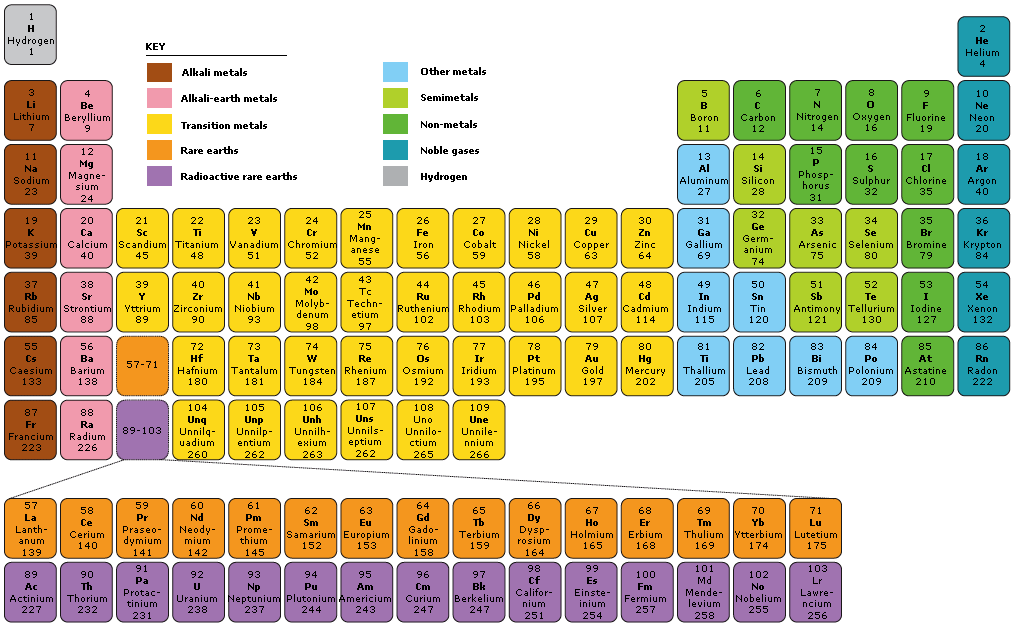DK Science: Periodic Table
At first glance, the periodic table looks very complex. In fact it is a large grid of every element that exists. The elements are arranged in order of their atomic number. The atomic number is the number of protons each atom has in its nucleus. By arranging the elements in this way, those with similar properties (characteristics) are grouped together. As with any grid, the periodic table has rows running left to right, and columns running up and down. The rows are called PERIODS and the columns are called GROUPS.

Hydrogen (H) is the first element in the periodic table because it has just one proton in its nucleus. Helium (He) is second, because it has two protons, and so on. The periodic table can be coloured-coded. Often, each group is given a particular colour so that it is easy to pick out all the elements that belong to a particular group.

As well as a name, each element has a symbol, a shorthand way of writing the element in chemical equations. Often this is the first letter or two of the element’s name, but it can come from a Latin name. Each also has an atomic number and a mass number.
One element that Mendeleyev left a gap for in his periodic table was gallium (element 31). Mendeleyev called it eka-aluminium because he predicted it would have similar properties to aluminium. In 1875, French scientist Lecoq de Boisbaudran discovered gallium. It has the exact properties that Mendeleyev predicted. Gallium is a soft, silvery metal with a melting point of 29.8ºC (85.6ºF).
This chemist was convinced there was an order to the elements. He collected information on each one and, in 1869, he published a table of elements on which the modern periodic table is based. He left gaps for elements he predicted would be found, such as gallium, germanium, and scandium.
There are 18 groups (columns) in the periodic table. Group 1 (also known as the alkali metals) is the column on the far left of the table. Elements in the same group have similar, but not identical characteristics. This is because they all have the same number of electrons in their outermost shell. You can tell a lot about an element just by knowing which group it is in.
As you move down one element in a group, there is a large jump in the number of protons and neutrons in the nucleus, and a new shell of electrons is added. The extra particles make the atom heavier and the extra shell of electrons makes the atom take up more space.
An astronaut’s visor is gold-plated to reflect sunlight. This shiny, hard-wearing metal does not corrode (rust), making it ideal for use in space, where materials cannot be replaced easily. Gold, copper, and silver belong to group 11. Group 11 metals are also called coinage metals, because they are used to make coins.
The properties of the elements across a period (row) change gradually. The first and last elements are very different. The first is a reactive solid – it catches fire when it mixes with oxygen – and the last is an unreactive gas. However, they have the same number of electron shells. All the elements in the third period, for example, have three shells for their electrons.

Magnesium is a highly reactive metal. This means that it reacts with water and burns violently in air. Because of this, magnesium always combines with other elements, and is not found on its own in nature.
As you go across a period, the atoms get slightly heavier, but they also get smaller. This is because the number of electron shells stays the same across the period, but the number of protons in the nucleus increases. The stronger, attractive force from the positively charged protons sucks the negatively charged electrons tighter into the centre.
Phosphorus is a non-metal element. It is a yellowish, waxy, slightly see-through solid. Like magnesium, it is very reactive. Because of this, phosphorus compounds are used on the tips of matches. Phosphorus glows in the dark, an effect called phosphorescence.
